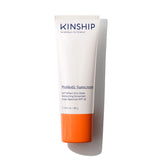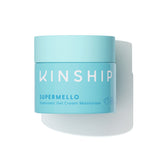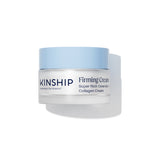Mineral sunscreens are taking over the skincare world, and for good reason. They offer safer means of sun protection compared to chemical alternatives, using active ingredients that physically block harmful UV rays.
Two of the most popular mineral UV filters are Zinc Oxide and Titanium Dioxide.
While both are effective at protecting your skin from the sun, they each have distinct properties that can make them a better fit for specific skin types and concerns.
If you have ever wondered which ingredient works best for your skin type and lifestyle, you are in the right place.
Let’s dive into the details of Zinc Oxide vs Titanium Dioxide to help you decide which is more appropriate for your needs.

What Is Zinc Oxide?

Zinc Oxide is a naturally occurring mineral that serves as a broad-spectrum UV filter, protecting against both UVA and UVB rays.
Sunscreens like Kinship’s Self Reflect Probiotic Sunscreen, often containing zinc oxide, work by scattering and absorbing harmful UV radiation, creating a physical shield on your skin’s surface.
Benefits:
- Broad-Spectrum Protection: Zinc Oxide offers comprehensive protection against both UVA and UVB rays, making it one of the most effective mineral blockers available.
- Anti-Inflammatory Properties: Zinc oxide is known for its anti-inflammatory effects, which makes it ideal for sensitive skin. It helps to soothe irritation, reduce redness, and strengthen the skin barrier, promoting overall skin health.
- Suitable for All Ages: Zinc Oxide is gentle enough to be used on infants, making it a versatile option for every member of the family.
- Non-comedogenic: It does not clog pores, making it an excellent choice for acne-prone skin.
- Skin Barrier Support: Zinc Oxide helps maintain and strengthen the skin's natural barrier, which is essential for keeping the skin healthy and resilient.
Drawbacks:
- White Cast: One common downside is the white cast that Zinc Oxide can leave, particularly on darker skin tones. This can make it less appealing for those with deeper complexions.
- Thick Texture: Some Zinc Oxide formulations may have a thick, heavier texture that can feel uncomfortable, especially for those who prefer lightweight products.
- Application Challenges: Due to its thicker consistency, Zinc Oxide can sometimes be harder to blend into the skin evenly, which may lead to an uneven appearance.
What Is Titanium Dioxide?
Titanium Dioxide is another mineral commonly used in sunscreens to protect against UV rays. It effectively blocks UVB and short UVA rays by scattering and deflecting UV radiation from the skin’s surface.
Benefits:
- Lightweight Texture: Titanium Dioxide is known for its lightweight texture, which makes it more comfortable for daily use. It is especially suitable for those who dislike the heavier feel of some mineral sunscreens.
- Less Noticeable White Cast: Compared to Zinc Oxide, Titanium Dioxide tends to leave less of a white cast, making it more user-friendly for a broader range of skin tones.
- Non-Comedogenic: Titanium Dioxide does not clog pores, making it ideal for sensitive and acne-prone skin. Its gentle formulation helps prevent breakouts while offering effective sun protection.
- Quick Absorption: Due to its lightweight nature, Titanium Dioxide sunscreens tend to absorb more quickly into the skin, making them easier to apply and integrate into a skincare routine.
Drawbacks:
- Limited UVA Protection: While Titanium Dioxide is effective at blocking UVB rays, it doesn’t provide as much protection against longer UVA rays as Zinc Oxide does. This limits its efficacy as a broad-spectrum blocker when used on its own, making it less ideal for full UVA coverage.
- Not as Soothing: Unlike Zinc Oxide, Titanium Dioxide does not possess significant anti-inflammatory properties. Therefore, it may not be as soothing for individuals with highly reactive or inflamed skin.
- Less Effective for Long-Term Exposure: Titanium Dioxide is less effective at providing long-term protection during prolonged sun exposure, particularly against deeper UVA rays, which are more responsible for skin aging.
Recommended Products
Zinc Oxide vs Titanium Dioxide: Key Differences
When it comes to choosing between Zinc Oxide and Titanium Dioxide, understanding their key differences can help you determine which mineral sunscreen ingredient is best suited for your needs.
Both minerals are widely used in sunscreen formulations and offer unique benefits, but they also have distinct characteristics that make them better for different skin types and sun protection requirements.
Protection Spectrum
Zinc Oxide offers superior coverage for UVA rays, providing a more comprehensive spectrum of protection compared to Titanium Dioxide.
While Titanium Dioxide is highly effective against UVB rays, it provides less protection against longer UVA radiation.
UVA rays penetrate deeper into the skin and are largely responsible for skin aging, so Zinc Oxide is often the preferred choice for broad-spectrum protection.
Formulation and Texture
The texture of your sunscreen can play a huge role in how it feels on your skin and how likely you are to use it regularly.
Zinc Oxide tends to have a heavier consistency, which can be beneficial for those who need a more occlusive layer to protect their skin.
However, this heavier texture may also leave a noticeable white cast, especially on deeper skin tones, which can be a drawback for some users.
Titanium Dioxide, on the other hand, has a lighter texture that absorbs more quickly and tends to leave less of a white cast.
This makes Titanium Dioxide sunscreens more suitable for people looking for a lightweight, comfortable option that blends easily into the skin.
Safety and Skin Type Suitability
Both Zinc Oxide and Titanium Dioxide are gentle enough for sensitive skin, but there are subtle differences in their skin-soothing properties.
Zinc Oxide is known for its anti-inflammatory effects, making it an excellent choice for those with highly reactive or irritated skin. It helps calm redness and can provide relief for skin conditions such as eczema or rosacea.
Titanium Dioxide is also a good option for sensitive skin, but it may not offer the same level of soothing benefits as Zinc Oxide. Its lightweight nature, however, makes it an attractive choice for those who prefer a non-greasy finish.
Environmental Impact
Both Zinc Oxide and Titanium Dioxide are considered reef-safe, which means they do not contribute to coral reef bleaching like other chemical sunscreen ingredients do.
This makes them environmentally friendly choices for sun protection, especially if you are swimming in the ocean or concerned about the impact of your skincare products on marine life.
Using mineral sunscreens that contain these ingredients supports the preservation of marine ecosystems and aligns with a more eco-conscious approach to skincare.
Which Is Better for Your Skin Type?

Choosing the right sunscreen depends largely on your skin type and individual concerns.
Both Zinc Oxide and Titanium Dioxide have unique properties that make them ideal for certain skin types.
Understanding how each ingredient interacts with your skin can help you make a more informed choice. Below, we break down which mineral ingredient might work best for your specific needs:
- Sensitive Skin: Zinc Oxide is often the better choice because of its soothing and anti-inflammatory properties. It helps calm sensitive skin while providing comprehensive protection.
- Oily Skin: If you prefer something lightweight, Titanium Dioxide is a good fit. Its lighter texture feels more comfortable and won’t weigh down oily skin.
- Acne-Prone Skin: Both Zinc Oxide and Titanium Dioxide are non-comedogenic, which means they won’t clog pores. Zinc Oxide’s calming properties can also be especially beneficial for reducing redness and irritation.
- Dark Skin Tones: Titanium Dioxide tends to leave less of a white cast, making it more suitable for darker skin tones. However, newer Zinc Oxide formulations are improving in this area.
How to Choose the Right Mineral Sunscreen
Shopping for the right mineral sunscreen can feel overwhelming with so many options on the market, but it doesn’t have to be.
Both Zinc Oxide and Titanium Dioxide provide effective sun protection, but finding the perfect fit comes down to understanding your skin type, activity level, and personal preferences.
Below are some key tips to help you select the best mineral sunscreen for your needs:
- Consider Your Skin Type: If you have sensitive or reactive skin, look for a sunscreen containing Zinc Oxide (like Kinship’s Self Reflect), as it provides broad-spectrum protection and has anti-inflammatory properties that help calm irritation. For oily skin, a Titanium Dioxide-based sunscreen may be preferable because of its lightweight texture.
- Think About Texture: Texture plays a vital role in how comfortable sunscreen feels on your skin. Zinc Oxide often has a thicker consistency, which can benefit those needing a more occlusive layer. On the other hand, Titanium Dioxide offers a lighter, more breathable feel, ideal for daily use without feeling heavy.
- Level of Sun Exposure: If you are planning on prolonged sun exposure, such as spending the day outdoors, Zinc Oxide is a better choice due to its superior UVA protection. Titanium Dioxide is great for daily, moderate exposure when you need a lightweight sunscreen that absorbs quickly.
- Application and White Cast: If you are concerned about the white cast left by mineral sunscreens, Titanium dioxide tends to leave less residue than Zinc Oxide. For those with darker skin tones, this can be an important factor in ensuring a comfortable and invisible finish.
- Activity Level: If you are engaging in physical activities like swimming or sports, consider a combination of Zinc Oxide and Titanium Dioxide. This combined formula offers balanced, broad-spectrum protection while ensuring better resistance to sweat and water.
- Skin Concerns: If you are dealing with conditions like acne or rosacea, a Zinc Oxide sunscreen may be the better choice because of its non-comedogenic and calming properties. It can help reduce redness and irritation while keeping your skin protected.
Zinc Oxide and Titanium Dioxide in Combination
Many mineral sunscreens combine Zinc Oxide and Titanium Dioxide to harness the best qualities of both ingredients.
Zinc Oxide provides extended UVA protection, while Titanium Dioxide effectively blocks UVB rays. This combination can offer a balanced and effective approach to broad-spectrum protection.
NOTE: If you seek maximum efficacy, look for sunscreens that feature both or consider using both simultaneously.
Frequently Asked Questions (FAQs)
Who Should Not Use Zinc Oxide?
While Zinc Oxide is generally safe for most skin types, people with severe mineral allergies or those experiencing irritation after use should consult a dermatologist before using Zinc Oxide sunscreen.
Can I Use Regular Sunscreen With Zinc Oxide Sunscreen?
No. While it is possible to use both at the same time, skin care experts do not recommend doing so. This is because layering these sunscreens may affect the potency and absorption of the products, so it is best to stick to one kind for maximum sun protection.
How Often Should You Reapply Mineral Zinc Oxide Sunscreen?
To maintain effective sun protection, you should reapply every two hours, especially after swimming, sweating, or towel drying.
Key Takeaways on Zinc Oxide vs Titanium Dioxide
Choosing the right mineral sunscreen will depend on understanding the unique benefits of both Zinc Oxide and Titanium Dioxide.
Below is a summary of the key points discussed in this blog to help you make an informed decision:
- Broad-Spectrum Protection: Zinc Oxide provides more comprehensive UVA protection, which makes it ideal for preventing long-term skin aging. Titanium Dioxide, on the other hand, excels at protecting against UVB rays, which are primarily responsible for sunburn.
- Texture and Application: Titanium Dioxide has a lightweight texture that absorbs quickly into the skin, making it more suitable for those who dislike a heavy or greasy feel. Zinc Oxide, while effective, can have a thicker texture that may be challenging to blend, especially for deeper skin tones.
- Skin Type Considerations: For sensitive skin, Zinc Oxide is often the preferred choice thanks to its anti-inflammatory properties that help calm irritation and redness. Meanwhile, Titanium Dioxide works well for oily skin types because of its lighter consistency that doesn’t add any excess weight.
- Daily Comfort and Routine: Your ideal sunscreen should fit comfortably into your daily routine and make you feel good about applying it. Zinc Oxide, Titanium Dioxide, or a combination of both can provide effective sun protection. What matters most is finding a product that meets your specific needs and preferences.
- Environmental Benefits: Both Zinc Oxide and Titanium Dioxide are reef-safe, meaning they do not harm marine ecosystems. Opting for a mineral sunscreen with these ingredients helps protect the environment while keeping your skin safe.
Explore Kinship’s mineral sunscreen collection and discover clean formulations that prioritize both skin health and environmental impact. Find the ideal mineral sunscreen for your needs today!



